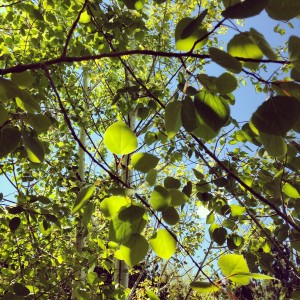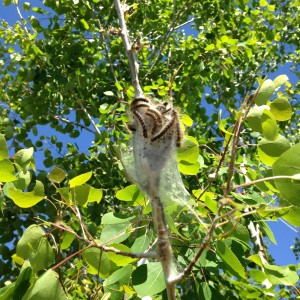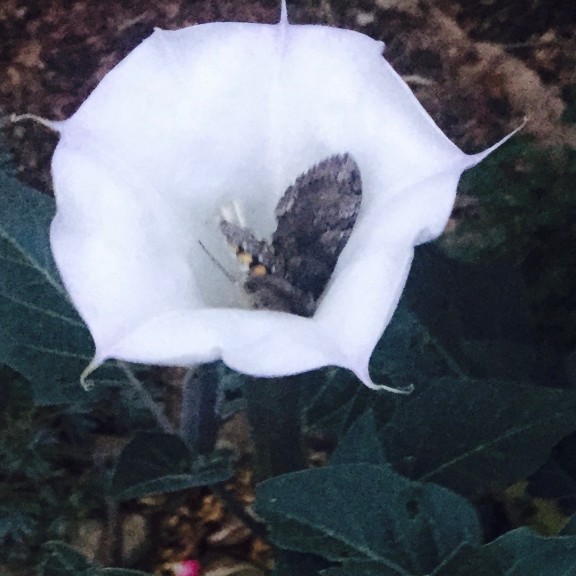Enemy Architects
 Look up.
Look up.
Hidden among the new spring leaves on your quaking aspens, you may see some finely wrought silk structures in strange, ethereal shapes that seem to have been borrowed from Euclid and then stretched. These odd nests are home to tent caterpillars, of the genus Malacosoma, which are among the most social of any caterpillar you might find. This means thousands of them can live together happily while exhibiting extraordinary communication skills.
Tent caterpillars hatch in early spring just as our aspen leaves are unfolding, and right away they start building. Ingeniously, they fabricate these structures to capitalize on the local micro-climate of your garden. These architects, much like their human counterparts, site their tents on the aspen so that the tent receives early morning sun. Within the tent, distinct layers of silk are used like walls to create different compartments with markedly different temperatures. This allows the caterpillars to adjust their body temperatures by moving from compartment to compartment within the tent, as one might move from room to room within a house that has an incredibly sophisticated, space-specific heating and cooling system.
For the gardener, the tent caterpillar’s feats of engineering are harbingers of destruction. Tent caterpillars eat only young leaves, and they must complete their larval development before the leaves on the host tree become too mature. They eat fast and often – usually several times a day – and it is not uncommon for a cluster to defoliate a tree with remarkable speed. Using pheromone trails, they communicate rapidly and effectively about newly discovered food sources.
What do to?
Get rid of tent caterpillars as soon as possible. Go to your local hardware store and buy a twelve-foot long telescoping pruner. Find a big black garbage bag. Chop the caterpillar tents out of your tree and directly into that bag. Repeat. Repeat again. Tie up the bag and make sure it is fully sealed; you do not want to distribute this mess, even to the neighbor of whom you are not fond, for the caterpillars do not know or care for your personal proclivities, and will summarily return to your trees for further nourishment. Dispose of the bag quickly.
For good measure, and because I strongly dislike pruning these swarming masses from my aspens, I spray some Monterey B.t. organic insecticide onto the branches of the tree. Ideally this should be sprayed at the first sign of eaten leaves, but it is helpful even late in the game. Once an infestation becomes apparent, it is good to reapply the Monterey B.t. every five to seven days. Concentrate the spray on young leaves, and not necessarily on the tents themselves, for it is the compound’s ingestion by the caterpillars that makes it effective.
As with so many extraordinary things in the natural world, it seems a pity to destroy something so magnificently architected —multi-roomed, highly sophisticated, climate-controlled structures that have been so finely honed to suit the needs of their inhabitants. But cut them away we must, because these pests can make short work of defoliating an entire forest, and because their pharate larvae are inured to the cold of winter, and can withstand winter temperatures of minus forty degrees centigrade. If you leave tent caterpillars to bask in the sun of your aspen branches, their children will be dining at the table of your garden next spring.
Look up again.
Once you notice the tent caterpillar’s tents, you will start seeing them everywhere, in all kinds of light-catching formations. And, as long as they are on the other side of town, take a little time and pleasure examining just how delicate and sophisticated is the work of these enemy architects.




